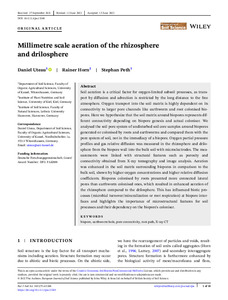| dc.date.accessioned | 2022-09-07T12:38:49Z | |
| dc.date.available | 2022-09-07T12:38:49Z | |
| dc.date.issued | 2022-06-22 | |
| dc.identifier | doi:10.17170/kobra-202207126458 | |
| dc.identifier.uri | http://hdl.handle.net/123456789/14133 | |
| dc.description.sponsorship | Gefördert im Rahmen des Projekts DEAL | ger |
| dc.description.sponsorship | Deutsche Forschungsgemeinschaft. Grant Number: DFG PAK888 | |
| dc.language.iso | eng | eng |
| dc.rights | Attribution-NonCommercial-NoDerivatives 4.0 International | * |
| dc.rights.uri | http://creativecommons.org/licenses/by-nc-nd/4.0/ | * |
| dc.subject | biopore | eng |
| dc.subject | earthworm hole | eng |
| dc.subject | pore connectivity | eng |
| dc.subject | root path | eng |
| dc.subject | X-ray CT | eng |
| dc.subject.ddc | 550 | |
| dc.subject.ddc | 570 | |
| dc.title | Millimetre scale aeration of the rhizosphere and drilosphere | eng |
| dc.type | Aufsatz | |
| dcterms.abstract | Soil aeration is a critical factor for oxygen-limited subsoil processes, as transport by diffusion and advection is restricted by the long distance to the free atmosphere. Oxygen transport into the soil matrix is highly dependent on its connectivity to larger pore channels like earthworm and root colonised biopores. Here we hypothesize that the soil matrix around biopores represents different connectivity depending on biopore genesis and actual coloniser. We analysed the soil pore system of undisturbed soil core samples around biopores generated or colonised by roots and earthworms and compared them with the pore system of soil, not in the immediacy of a biopore. Oxygen partial pressure profiles and gas relative diffusion was measured in the rhizosphere and drilosphere from the biopore wall into the bulk soil with microelectrodes. The measurements were linked with structural features such as porosity and connectivity obtained from X-ray tomography and image analysis. Aeration was enhanced in the soil matrix surrounding biopores in comparison to the bulk soil, shown by higher oxygen concentrations and higher relative diffusion coefficients. Biopores colonised by roots presented more connected lateral pores than earthworm colonised ones, which resulted in enhanced aeration of the rhizosphere compared to the drilosphere. This has influenced biotic processes (microbial turnover/mineralization or root respiration) at biopore interfaces and highlights the importance of microstructural features for soil processes and their dependency on the biopore's coloniser. | eng |
| dcterms.accessRights | open access | |
| dcterms.creator | Uteau, Daniel | |
| dcterms.creator | Horn, Rainer | |
| dcterms.creator | Peth, Stephan | |
| dc.relation.doi | doi:10.1111/ejss.13269 | |
| dc.relation.projectid | Grant/Award Number: DFG PAK888 | |
| dc.subject.swd | Pore | ger |
| dc.subject.swd | Wurzel | ger |
| dc.subject.swd | Regenwurm | ger |
| dc.subject.swd | Porosität | ger |
| dc.subject.swd | Physikochemische Bodeneigenschaft | ger |
| dc.subject.swd | Rhizosphäre | ger |
| dc.subject.swd | Bildanalyse | ger |
| dc.type.version | publishedVersion | |
| dcterms.source.identifier | eissn:1365-2389 | |
| dcterms.source.issue | Issue 4 | |
| dcterms.source.journal | European Journal of Soil Science (EJSS) | eng |
| dcterms.source.volume | Volume 73 | |
| kup.iskup | false | |
| dcterms.source.articlenumber | e13269 | |


